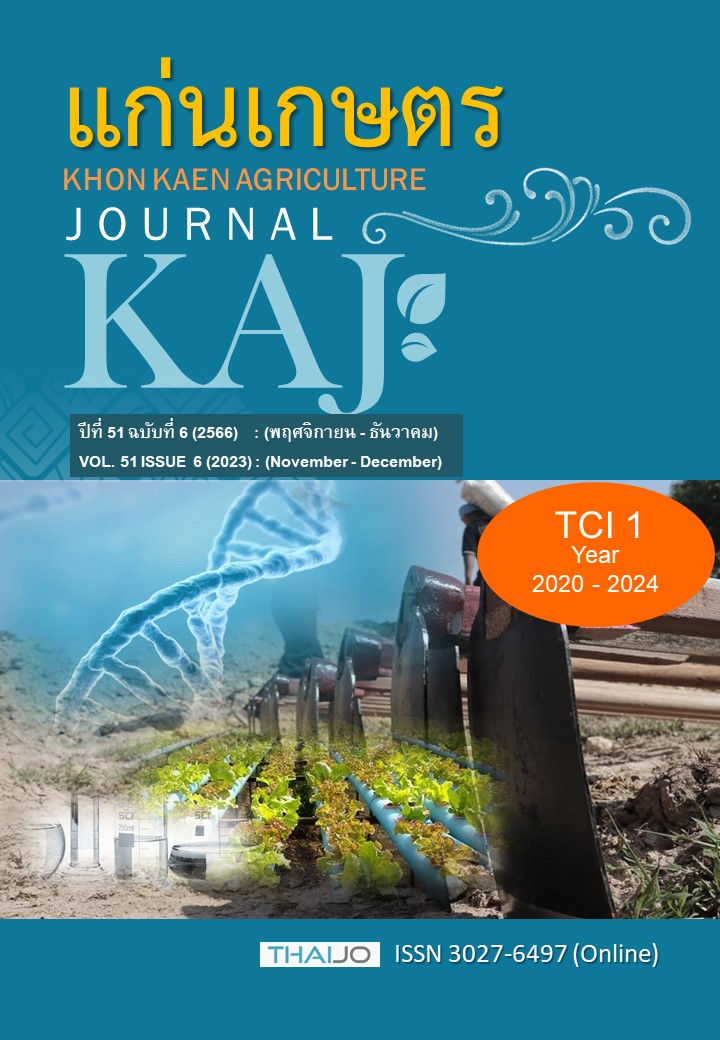How do farmers' groups and cooperatives support smallholder farmers? A Case of Eastern Bhutan
Main Article Content
บทคัดย่อ
The number of registered farmers' groups (FGs) and cooperatives (Coops) increases yearly in Bhutan. However, the benefits of these collective actions are under-researched, particularly in Eastern Bhutan. Thus, we endeavored this research to assess FGs and Coops' benefits covering the six districts of Eastern Bhutan. Data for this study came from interviewing 301 members of FGs and Coops. Our results show that FGs and Coops moderately benefited in terms of economic, human resource development, inputs and infrastructure access, and socio-culture. We discussed these benefits with a few challenges, with examples and evidence wherever possible. The study findings are useful for promoters of FGs and Coops in Bhutan and other developing countries.
Article Details

อนุญาตภายใต้เงื่อนไข Creative Commons Attribution-NonCommercial-NoDerivatives 4.0 International License.
เอกสารอ้างอิง
APIC. 2012. Cane and Bamboo products - Catalogue – 2012. MoEA, RGoB, Thimphu, Bhutan.
APIC. 2013. Woodwork: product catalogue. MoEA, RGoB, Thimphu, Bhutan.
Aref, F. 2011. Agricultural cooperatives for agricultural development in Iran. Life Science Journal. 8(1): 82-85.
Asante, B.O., V. Afarindash, and D.B. Sarpong. 2011. Determinants of small scale farmers decision to join farmer-based organizations in Ghana. African Journal of Agricultural Research. 6: 2273-2279.
Cohen, D. and L. Prusak. 2001. In good company: how social capital makes organizations work (Vol. 15). Harvard Business School Press, Boston, MA, USA.
DAMC. 2018. The contribution of co-operatives and farmers groups to regular paid jobs. RGoB, Thimphu, Bhutan.
DAMC. 2019a. Report on the evaluation of farmers groups and cooperatives. RGoB, Thimphu, Bhutan.
DAMC. 2019b. Department of Agricultural Marketing and Cooperatives. Available: http://www.agrimarket.gov.bt/public/index/about/id/1. Accessed Aug. 10, 2019.
DAMC. 2019c. Annual Report 2018-2019. RGoB, Thimphu, Bhutan.
Dendup, T. 2018. Agricultural transformation in Bhutan: From peasants to entrepreneurial farmers. Asian Journal of Agricultural Extension, Economics and Sociology. 23(3): 1-8.
Dendup, T., and S. Aditto. 2020. Benefits of agriculture cooperatives to their member households in Bhutan. Khon Kaen Agriculture Journal. 48(5): 1184-1193.
Edelman, L.F., M. Bresnen, S. Newell, H. Scarbrough, and J. Swan. 2004. The benefits and pitfalls of social capital: empirical evidence from two organizations in the United Kingdom. British Journal of Management. 15(1): 59-69.
Egerstrom, L. 2001. New generation cooperatives as an economic development strategy. In A cooperative approach to local economic development. 73-90.
Eum, H. 2017. Cooperatives and employment second global report: Contribution of cooperatives to decent work in the changing world of work. International organization of cooperatives in industry and services (CICOPA). Geneva: Switzerland.
Feuerbacher, A., J. Luckmann, O. Boysen, S. Zikeli, and H. Grethe. 2018. Is Bhutan destined for 100% organic? Assessing the economy-wide effects of a large-scale conversion policy. PloS one. 13(6): e0199025.
Gargiulo, M., and M. Benassi. 2000. Trapped in your own net? Network cohesion, structural holes, and the adaptation of social capital. Organization Science. 11(2): 183-196.
Getnet, K., and T. Anullo. 2012. Agricultural cooperatives and rural livelihoods: Evidence from Ethiopia. Annals of Public and Cooperative Economics. 83(2): 181-198.
International Cooperative Alliance. 2018. Cooperative identity, values & principles. Available: https://www.ica.coop/en/cooperatives/cooperative-identity#definition-of-a-cooperative. Accessed Jan. 7, 2021.
Meulenberg, M. T. G. 2000. Voluntarily marketing institutions in food marketing systems. In A. van Tilburg, H. A. J. Moll, and A. Kuyvenhoven (Eds.), Agricultural markets beyond liberalization (pp. 213–233). Kluwer Academic Publishers, Boston.
MoAF. 2019. Bhutan RNR Statistics 2019. RGoB, Thimphu, Bhutan.
MoEA. 2006. Dzongkhag-wise Inventory of Resources –Bhutan. Eastern Region. Thimphu, Bhutan.
Mojo, D., C. Fischer, and T. Degefa. 2015. Social and environmental impacts of agricultural cooperatives: evidence from Ethiopia. International Journal of Sustainable Development & World Ecology. 22(5): 388-400.
Msuta, P. B., and J. K. Urassa. 2015. The contribution of farmers organizations to smallholder farmers wellbeing: A case study of Kasulu district, Tanzania. African Journal of Agricultural Research. 10(23): 2343-2349.
National Statistics Bureau. 2020. Statistical Yearbook of Bhutan. RGoB, Thimphu, Bhutan.
Ortmann, G.F., and R.P. King. 2007a. Agricultural cooperatives I: History, theory and problems. Agrekon. 46 (1): 18-46.
Ortmann, G.F., and R.P. King. 2007b. Agricultural cooperatives II: Can they facilitate access of small-scale farmers in South Africa to input and product markets? Agrekon. 46(2): 219-244.
Pelzom, T., and O. Katel. 2018. Youth perception of agriculture and potential for employment in the context of rural development in Bhutan. Development, Environment and Foresight. 3(2): 92-106.
Sherpa, D. L. 2010. Dairy co-operatives in Bhutan: Understanding potentials towards co-operative chain development. Master's degree thesis, University of Applied Sciences.
Sonam, T., and N. Martwanna. 2011. Smallholder dairy farmers' group development in Bhutan: Strengthening rural communities through group mobilization. Khon Kaen Agriculture Journal. 39: 413-428.
Sonam, T., and N. Martwanna. 2012. Performance of smallholder dairy farmers groups in the east and west central regions of Bhutan: Members perspective. Journal of Agricultural Extension and Rural Development. 4(1): 23-29.
Tashi, S., and K. Wangchuk. 2016. Prospects of organic farming in Bhutan: A SWOT analysis. Advances in Agriculture. 1-19.
Tenzin, G., and K. Natsuda. 2016. Social capital, household income, and community development in Bhutan: a case study of a dairy cooperative. Development in Practice. 26(4): 467-480.
Tenzin, G., K. Otsuka, and K. Natsuda. 2015. Can social capital reduce poverty? A study of rural households in eastern Bhutan. Asian Economic Journal. 29(3): 243-264.
Tshering, S. 2017. Khengkhar’s Palang business grows. Available: http://www.bbs.bt/news/?p=81747. Accessed Jan. 7, 2020.
Wang, S. L. 2014. Cooperative extension system: Trends and economic impacts on US agriculture. Choices. 29(1): 1-8.
Wang, S. W., B. Manjur, J. G. Kim, and W. K. Lee. 2019. Assessing socio-economic impacts of agricultural subsidies: A case study from Bhutan. Sustainability. 11 (12): 3266.
Wangchuk, K., T. Dorji, J. Wangdi, M. Wurzinger, and W. Zollitsch. 2019. Caught in the middle: Reasons for hindered growth among dairy groups of Haa district in Western Bhutan. Advance Dairy Research. 7:1-9.
Wangdi, N. 2016. Shazo industry booming in Trashiyangtse. Available: https://kuenselonline.com/shazo-industry-booming-in-trashiyangtse/. Accessed Aug. 25, 2020.
Wanyama, F., P. Develtere, and I. Pollet. 2008. Encountering the evidence: Co-operatives and poverty reduction in Africa. Journal of Co-operative Studies. 41(3): 16-27.
Yamane, T. 1967. Statistics, An Introductory Analysis. 2nd Edition. Harper and Row, New York.


